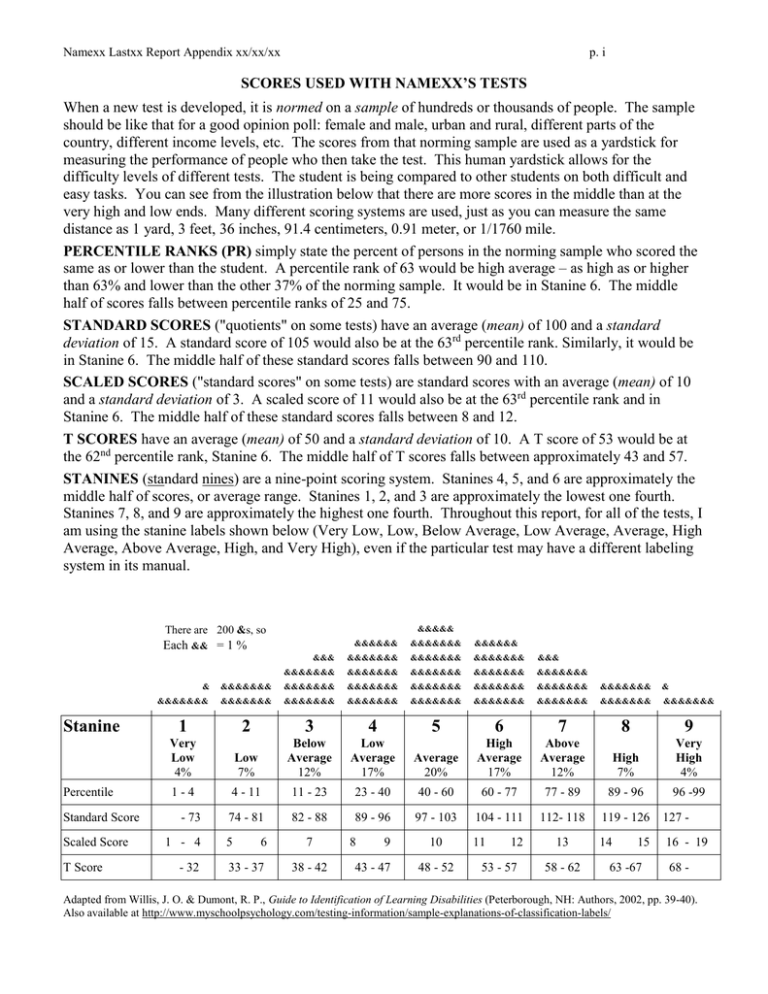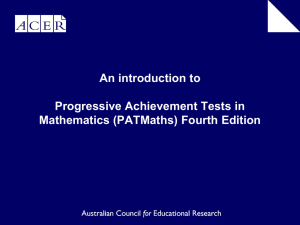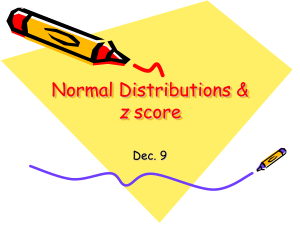NAMEXX*S TEST SCORES - My School Psychology
advertisement

Namexx Lastxx Report Appendix xx/xx/xx p. i SCORES USED WITH NAMEXX’S TESTS When a new test is developed, it is normed on a sample of hundreds or thousands of people. The sample should be like that for a good opinion poll: female and male, urban and rural, different parts of the country, different income levels, etc. The scores from that norming sample are used as a yardstick for measuring the performance of people who then take the test. This human yardstick allows for the difficulty levels of different tests. The student is being compared to other students on both difficult and easy tasks. You can see from the illustration below that there are more scores in the middle than at the very high and low ends. Many different scoring systems are used, just as you can measure the same distance as 1 yard, 3 feet, 36 inches, 91.4 centimeters, 0.91 meter, or 1/1760 mile. PERCENTILE RANKS (PR) simply state the percent of persons in the norming sample who scored the same as or lower than the student. A percentile rank of 63 would be high average – as high as or higher than 63% and lower than the other 37% of the norming sample. It would be in Stanine 6. The middle half of scores falls between percentile ranks of 25 and 75. STANDARD SCORES ("quotients" on some tests) have an average (mean) of 100 and a standard deviation of 15. A standard score of 105 would also be at the 63rd percentile rank. Similarly, it would be in Stanine 6. The middle half of these standard scores falls between 90 and 110. SCALED SCORES ("standard scores" on some tests) are standard scores with an average (mean) of 10 and a standard deviation of 3. A scaled score of 11 would also be at the 63rd percentile rank and in Stanine 6. The middle half of these standard scores falls between 8 and 12. T SCORES have an average (mean) of 50 and a standard deviation of 10. A T score of 53 would be at the 62nd percentile rank, Stanine 6. The middle half of T scores falls between approximately 43 and 57. STANINES (standard nines) are a nine-point scoring system. Stanines 4, 5, and 6 are approximately the middle half of scores, or average range. Stanines 1, 2, and 3 are approximately the lowest one fourth. Stanines 7, 8, and 9 are approximately the highest one fourth. Throughout this report, for all of the tests, I am using the stanine labels shown below (Very Low, Low, Below Average, Low Average, Average, High Average, Above Average, High, and Very High), even if the particular test may have a different labeling system in its manual. &&&&& There are 200 &s, so &&&&&& &&&&&&& &&&&&& &&& &&&&&&& &&&&&&& &&&&&&& &&& &&&&&&& &&&&&&& &&&&&&& &&&&&&& &&&&&&& Each && = 1 % Stanine Percentile Standard Score Scaled Score T Score & &&&&&&& &&&&&&& &&&&&&& &&&&&&& &&&&&&& &&&&&&& &&&&&&& & &&&&&&& &&&&&&& &&&&&&& &&&&&&& &&&&&&& &&&&&&& &&&&&&& &&&&&&& &&&&&&& 1 2 3 4 5 6 7 8 9 Very Low 4% Low 7% Below Average 12% Low Average 17% Average 20% High Average 17% Above Average 12% High 7% Very High 4% 1-4 4 - 11 11 - 23 23 - 40 40 - 60 60 - 77 77 - 89 89 - 96 96 -99 74 - 81 82 - 88 89 - 96 97 - 103 104 - 111 112- 118 119 - 126 127 - 14 16 - 19 - 73 1 - 4 - 32 5 6 33 - 37 7 38 - 42 8 9 43 - 47 10 48 - 52 11 12 53 - 57 13 58 - 62 15 63 -67 68 - Adapted from Willis, J. O. & Dumont, R. P., Guide to Identification of Learning Disabilities (Peterborough, NH: Authors, 2002, pp. 39-40). Also available at http://www.myschoolpsychology.com/testing-information/sample-explanations-of-classification-labels/ Namexx Lastxx Report Appendix xx/xx/xx p. ii SCORES NOT USED WITH THE TESTS IN THIS REPORT (GIVEN FOR REFERENCE) When a new test is developed, it is normed on a sample of hundreds or thousands of people. The sample should be like that for a good opinion poll: female and male, urban and rural, different parts of the country, different income levels, etc. The scores from that norming sample are used as a yardstick for measuring the performance of people who then take the test. This human yardstick allows for the difficulty levels of different tests. The student is being compared to other students on both difficult and easy tasks. You can see from the illustration below that there are more scores in the middle than at the very high and low ends. Many different scoring systems are used, just as you can measure the same distance as 1 yard, 3, feet, 36 inches, 91.4 centimeters, 0.91 meter, or 1/1760 mile. PERCENTILE RANKS (PR) simply state the percent of persons in the norming sample who scored the same as or lower than the student. A percentile rank of 50 would be Average – as high as or higher than 50% and lower than the other 50% of the norming sample. The middle half of scores falls between percentile ranks of 25 and 75. STANDARD SCORES ("quotients" on some tests) have an average (mean) of 100 and a standard deviation of 15. A standard score of 100 would also be at the 50th percentile rank. The middle half of these standard scores falls between 90 and 110. SCALED SCORES ("standard scores on some tests) are standard scores with an average (mean) of 10 and a standard deviation of 3. A scaled score of 10 would also be at the 50th percentile rank. The middle half of these standard scores falls between 8 and 12. T SCORES have an average (mean) of 50 and a standard deviation of 10. A T score of 50 would be at the 50th percentile rank. The middle half of T scores falls between approximately 43 and 57. STANINES (standard nines) are a nine-point scoring system. Stanines 4, 5, and 6 are approximately the middle half of scores, or average range. Stanines 1, 2, and 3 are approximately the lowest one fourth. Stanines 7, 8, and 9 are approximately the highest one fourth. Throughout this report, for all of the tests, I am using the stanine labels shown below (Very Low, Low, Below Average, Low Average, Average, High Average, Above Average, High, and Very High), even if the particular test may have a different labeling system in its manual. There are 200 &s. Each && = 1%. && &&&&&& &&&&&& &&&&&& &&&&&& &&&&&& &&&&&& &&&&&& &&&&&& && &&&&&& &&&&&& &&&&&& &&&&&& &&&&&& &&&&&& &&&&&& &&&&&& & & & & & &&&&&& &&&&&& && &&&&&& &&&&&& &&&&&& &&&&&& &&&&&& Percent in each 2.2% 6.7% 16.1% 50% 16.1% 6.7% 2.2% Standard Scores – 69 70 – 79 80 – 89 90 – 109 110 – 119 120 – 129 130 – Scaled Scores T Scores Percentile Ranks KTEA-3 10-pt. Classification KTEA-3 15-pt. Classification Stanines 1 2 3 – 29 – 02 Very Low – 69 Very Low Low 40-54 55-69 Very Low – 73 4 5 30 – 36 6 7 8 9 37 – 42 Below Average 82 - 88 11 & &&&&&& &&&&&& 12 43 – 56 03 – 08 09 – 24 Low Below 70 – 79 Average Below Average 70 – 84 Low 74 – 81 10 && &&&&&& &&&&&& &&&&&& &&&&&& &&&&&& 57 – 62 25 – 74 Average (90 – 109) Average 85 – 115 Low Average 89 – 96 Average 97 – 103 13 14 15 63 – 69 75 – 90 91 – 97 Above High Average 120 – 129 Above Average 116 – 130 High Average Above Average 104 - 111 112 – 118 High 119 – 126 & & & & 16 17 18 19 70 – 98 – Very High 130 – High 131145 Very High 146--160 Very High 127 – Adapted from Willis, J. O. & Dumont, R. P., Guide to Identification of Learning Disabilities (Peterborough, NH: Authors, 2002, pp. 39-40). Also available at http://www.myschoolpsychology.com/testing-information/sample-explanations-of-classification-labels/ Namexx Lastxx Report Appendix xx/xx/xx p. iii Namexx's KTEA-3 Test Scores in Standard Scores, Percentile Ranks, and Stanines for hxx Age Test Standard Score1 95% Confidence2 PercenStanine4 3 tile 123456789 Reading Decoding KTEA-3: reading words aloud from a list KTEA-3: reading nonsense words aloud (to test phonics) KTEA-3: Reading Decoding Composite Score Reading Fluency KTEA-3: speed and accuracy in reading words aloud from a list KTEA-3: speed and accuracy in reading nonsense words aloud KTEA-3: speed of reading short sentences and marking yes or no KTEA-3: Reading Fluency Composite Score Reading Comprehension KTEA-3: answering reading comprehension questions about passages KTEA-3: reading vocabulary: word meanings KTEA-3: Reading Understanding Composite Phonology and Phonics KTEA-3: rhyming, separating, deleting sounds in spoken words KTEA-3: reading nonsense words aloud (to test phonics) KTEA-3: Sound-Symbol Composite Score Total Reading KTEA-3: reading words aloud from a list KTEA-3: answering reading comprehension questions about passages KTEA-3: Reading Composite Score Rapid Automatized Naming and Retrieval Speed KTEA-3: speed of naming things in specific categories KTEA-3: speed of naming rows of pictures KTEA-3: Oral Fluency Composite Score Writing KTEA-3: writing words and sentences in a story, and a summary KTEA-3: written spelling of dictated words KTEA-3: Written Language Composite Score Orthographic Processing KTEA-3: speed and accuracy in reading words aloud KTEA-3: written spelling of dictated words KTEA-3: speed of naming letters printed in rows KTEA-3: Orthographic Processing Composite 1 These are the standard scores used by the test publishers (please see the second page of this appendix). The percentile ranks and stanines in the last columns provide a common measurement that is the same for all of the tests (please see the first page of this appendix). 2 Test scores can never be perfectly reliable, even on the very best tests. Lucky and unlucky guesses, barely beating or missing time limits, and other random influences inevitably alter scores. This score interval shows how much scores are likely to vary 95% of the time just by pure chance. 3 Percentile ranks tell the percentage of students of the same age or grade whose scores Namexx tied or exceeded. For example, a percentile rank of 36 would mean that Namexx scored as high as or higher than 36 percent of peers and lower than the other 64 percent. 4 Stanines range from 1 (Very Low) to 9 (Very High). The middle half (actually 54%) of scores falls in the broad average range or stanines 4, 5, and 6 (Low Average, Average, and High Average). These are not the classifications used by the publishers. Namexx Lastxx Report Appendix xx/xx/xx Test p. iv Standard Score5 95% Confidence6 PerStanine8 cen123456789 tile7 Math KTEA-3: math applications ("story" or "word" problems) KTEA-3: math computation with paper and pencil KTEA-3: Math Composite Score Oral Language KTEA-3: oral expression: telling, explaining, answering KTEA-3: answering questions about dictated passages KTEA-3: speed of naming things in specific categories KTEA-3: Oral Language Composite Score Comprehension KTEA-3: answering reading comprehension questions about passages KTEA-3: answering questions about dictated passages KTEA-3: Comprehension Composite Expression KTEA-3: writing words and sentences in a story, and a summary KTEA-3: oral expression: telling, explaining, answering KTEA-3: Expression Composite Academic Fluency KTEA-3: speed and accuracy in reading words aloud from a list KTEA-3: speed and accuracy performing simple math calculations KTEA-3: speed and accuracy in writing short, simple sentences KTEA-3: Academic Fluency Composite Academic Skills KTEA-3: reading words aloud from a list KTEA-3: answering reading comprehension questions about passages KTEA-3: math applications ("story" or "word" problems) KTEA-3: math computation with paper and pencil KTEA-3: writing words and sentences in a story, and a summary KTEA-3: written spelling of dictated words KTEA-3: Academic Skills Composite * The scores in this composite are significantly different from each other if the difference is too large to occur just by random variation more than 5 times in 100. ** The difference is also "uncommon." No more than 10% of students obtain such large differences between the scores. NW = Normative weakness. PW = Personal weakness significantly lower than Namexx's total score on the test. NS = Normative strength. PS = Personal strength significantly higher than Namexx's total score on the test. 5 These are the standard scores used by the test publishers (please see the second page of this appendix). The percentile ranks and stanines in the last columns provide a common measurement that is the same for all of the tests (please see the first page of this appendix). 6 Test scores can never be perfectly reliable, even on the very best tests. Lucky and unlucky guesses, barely beating or missing time limits, and other random influences inevitably alter scores. This score interval shows how much scores are likely to vary 95% of the time just by pure chance. 7 Percentile ranks tell the percentage of students of the same age or grade whose scores Namexx tied or exceeded. For example, a percentile rank of 36 would mean that Namexx scored as high as or higher than 36 percent of peers and lower than the other 64 percent. 8 Stanines range from 1 (Very Low) to 9 (Very High). The middle half (actually 54%) of scores falls in the broad average range or stanines 4, 5, and 6 (Low Average, Average, and High Average). These are not the classifications used by the publishers. Namexx Lastxx Report Appendix xx/xx/xx p. v Kaufman Test of Educational Achievement, 3rd ed. (KTEA-3). Alan S. Kaufman & Nadeen L. Kaufman, Pearson, 2014. The KTEA-3 is an individual achievement test presented on an easel with only one or a few items per page. Items are not multiple-choice. It was normed on a stratified, random, nationwide sample of 2,050 persons of ages 4:0 through 25:11 and 2,600 students in grades pre-K through 12 in 48 states. Half of the samples took Form A and half took Form B. The samples closely match 2012 U.S. Census data. Scores can be based on the student’s age and/or on the student’s grade placement. There are separate fall, winter (interpolated), and spring norms for grade-based scores, which can cause discontinuities between November and December, between February and March, and between July and August for younger children. Age-based norms are in sets of 3 months for ages 4 and 5, 4 months for ages 6 through 13, 12 months for ages 14 through 16, and 24 months for ages 17 through 20. There is a single set of norms for ages 21 through 25. Samples of examinees also took the KTEA-II, WIAT-III, KABC-II, DAS-II, or WJ III. Special group studies were done with children who had specific learning disorders in reading and/or written expression or in mathematics; who had language disorders, intellectual disabilities, or attentiondeficit/hyperactivity disorder; or who were intellectually gifted. There are extensive error-analysis procedures. Phonological Processing: rhyming, matching, blending, segmenting and deleting sounds in spoken words. Letter & Word Recognition: reading words aloud from a list. Nonsense Word Decoding: reading nonsense words aloud to test phonics skills. Reading Comprehension: for most items, reading a brief paragraph and orally answering questions printed at the end of the paragraph. The earliest items require matching printed words to pictures and following printed directions, e.g., “Raise your hand.” Reading Vocabulary: early items require pointing to the 1 of 3 words that has same meaning as the target. Later items require reading a sentence and selecting the word with the same meaning as the target. Word Recognition Fluency: speed of reading words aloud. Decoding Fluency: speed of reading nonsense words aloud. Silent Reading Fluency: The student reads short sentences and marks each one yes or no to indicate its truth. The score is the number correct in two minutes. Spelling: writing dictated words. Written Expression: a variety of writing activities, including writing an essay. Writing Fluency: speed of writing brief sentences based on picture prompts telling “Who is doing what.” Math Computation: math calculation with printed problems on paper. Math Concepts & Applications: verbally framed math “word problems” read aloud to the student and accompanied by illustrations or a printed copy of the problem. Paper and pencil are allowed. Math Fluency: speed of performing simple math calculations on paper. Listening Comprehension: the examinee listens to stories played from a CD and answers oral questions about the stories. Oral Expression: a variety of oral expression tasks, such as combining two sentences into one, creating sentences using specified words, and telling what is happening in pictures. Associational Fluency: speed of naming words in specific categories. Object Naming Facility: speed of naming pictures printed in rows on a page. Letter Naming Facility: speed of naming letters printed in rows on a page.





